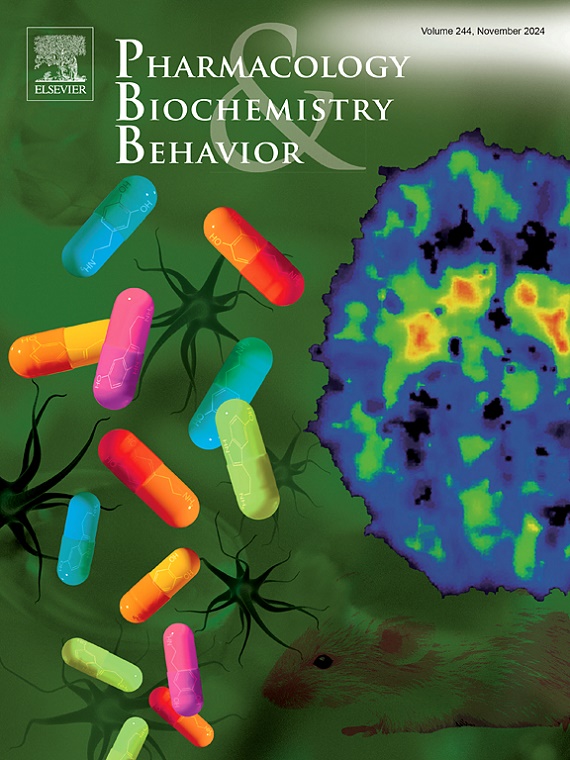Astrocyte gap junction dysfunction activates JAK2-STAT3 pathway to mediate inflammation in depression
IF 3.3
3区 心理学
Q1 BEHAVIORAL SCIENCES
引用次数: 0
Abstract
Connexin 43 (Cx43) is highly expressed in astrocytes and forms gap junctions that maintain intercellular communication. Dysfunctional gap junctions in astrocytes exacerbate depressive symptoms, which has been implicated in the pathogenesis of depression. Inflammatory responses occur in the brains of most people with depression. However, it is unclear whether dysfunctional astrocyte gap junctions mediate the onset of the inflammatory response in the brains of depressed patients. Transporter protein (TSPO), the most common neuroinflammatory marker and a novel target of antidepressants identified in recent years, is mainly expressed by glial cells in the brain and is abnormally upregulated during inflammatory activation. We found that in a mouse model of chronic unpredictable stress (CUS), astrocyte gap junctions in the prefrontal cortex are impaired and the JAK2-STAT3 signaling pathway is activated, leading to an increase in the inflammatory marker TSPO. Based on this finding, we further verified using Cx43 transgenic mice that conditional knockdown of Cx43 in prefrontal cortex astrocytes also activated the JAK2-STAT3 inflammatory signaling pathway, with concomitant elevated levels of the inflammatory marker TSPO, and the mice developed depressive-like behavior. In contrast, impaired corticosterone (CORT)-induced gap junction function and increased TSPO were ameliorated by the JAK2-STAT3 inhibitor protosappanin A (PTA). Thus, targeting astrocyte Cx43 attenuates the inflammatory response in depression and improves depressive symptoms. This provides a new perspective on the pathogenesis of depression and a new therapeutic target for antidepressant research.
星形胶质细胞间隙连接功能障碍激活JAK2-STAT3通路介导抑郁症炎症。
连接蛋白43 (Cx43)在星形胶质细胞中高表达,形成维持细胞间通讯的间隙连接。星形胶质细胞中功能失调的间隙连接加剧了抑郁症状,这与抑郁症的发病机制有关。大多数抑郁症患者的大脑都有炎症反应。然而,目前尚不清楚功能失调的星形胶质细胞间隙连接是否介导了抑郁症患者大脑炎症反应的发生。转运蛋白(Transporter protein, TSPO)是近年来发现的最常见的神经炎症标志物和抗抑郁药物的新靶点,主要由脑胶质细胞表达,在炎症激活过程中异常上调。我们发现,在小鼠慢性不可预测应激(CUS)模型中,前额叶皮层的星形胶质细胞间隙连接受损,JAK2-STAT3信号通路被激活,导致炎症标志物TSPO增加。基于这一发现,我们利用Cx43转基因小鼠进一步证实,前额皮质星形胶质细胞中Cx43的条件性敲低也激活了JAK2-STAT3炎症信号通路,同时炎症标志物TSPO水平升高,小鼠出现抑郁样行为。相比之下,皮质酮(CORT)诱导的间隙连接功能受损和TSPO升高可以通过JAK2-STAT3抑制剂原皂苷A (PTA)得到改善。因此,靶向星形胶质细胞Cx43可减轻抑郁症中的炎症反应并改善抑郁症状。这为研究抑郁症的发病机制提供了新的视角,也为抗抑郁药物的研究提供了新的治疗靶点。
本文章由计算机程序翻译,如有差异,请以英文原文为准。
求助全文
约1分钟内获得全文
求助全文
来源期刊
CiteScore
6.40
自引率
2.80%
发文量
122
审稿时长
38 days
期刊介绍:
Pharmacology Biochemistry & Behavior publishes original reports in the areas of pharmacology and biochemistry in which the primary emphasis and theoretical context are behavioral. Contributions may involve clinical, preclinical, or basic research. Purely biochemical or toxicology studies will not be published. Papers describing the behavioral effects of novel drugs in models of psychiatric, neurological and cognitive disorders, and central pain must include a positive control unless the paper is on a disease where such a drug is not available yet. Papers focusing on physiological processes (e.g., peripheral pain mechanisms, body temperature regulation, seizure activity) are not accepted as we would like to retain the focus of Pharmacology Biochemistry & Behavior on behavior and its interaction with the biochemistry and neurochemistry of the central nervous system. Papers describing the effects of plant materials are generally not considered, unless the active ingredients are studied, the extraction method is well described, the doses tested are known, and clear and definite experimental evidence on the mechanism of action of the active ingredients is provided.

 求助内容:
求助内容: 应助结果提醒方式:
应助结果提醒方式:


